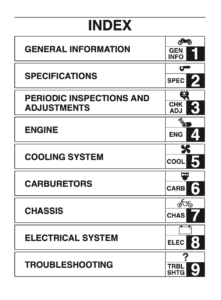Complete PDF version of the Service Manual for the Yamaha YZF-R7. A MUST for every R7 owner.
Download: Immediately after payment!
OEM Original factory workshop manual.
Models covered by this manual: 1999
Number of pages: 381 pages
Table of contents:

This PDF repair manual can be downloaded right after the payment process in complete, on the device of your choice. You will also receive the download link by email along with your receipt.
We do not offer printed manuals, for the following reasons:
- it is more eco-friendly to use a digital version
- your manual never gets dirty or greasy
- you can always choose to print the specific page(s) you need to work on your bike
- you receive your manual immediately after payment
- it is searchable

Yamaha YZF-R7
The Yamaha YZF-R7 or OW-02 is a race homologation motorbike produced in a limited run of 500 units. It was created to participate in the Superbike World Championship as well as the Suzuka 8 Hours endurance event.
It has a 749 cc (45.7 cu in) inline-four engine with a DOHC 20-valve (5 valves per cylinder) that produces 79 kW. (106 hp).
However, Yamaha also created two R7 race kits, the first of which generated 101 kW (135 hp) when the other, unused bank of fuel injectors was engaged, as well as a pipe and ECU upgrade.
The chassis, which was drawn from information and geometry from the YZR500 motorcycles of the time, meant that the R7 was constructed for racing “out of the box.”
It has Öhlins suspension components, titanium valves and conrods, a shorter Deltabox II frame, and a dry weight of 189 kg (416 lb).
Due to its extraordinary price, top-spec Öhlins race suspension and running gear, and that the bike looked utterly amazing: genuine two-wheeled sex, Super Streetbikes magazine ranked the R7 eighth in its list, “The 10 Most Exotic Bikes Ever,” but said it was ironic that despite being the most exotic R-series bike ever, it actually turned out to be a bit of a lemon.
The difficulty was that the bike was crippled, with just 100 horsepower, and that tiny teams couldn’t afford the thousands of dollars in racing improvements required to make the R7 competitive, and when they did, the crankshafts broke. Yamaha chose to detune the engines for bikes imported into all countries to meet the German market’s maximum horsepower regulation for the sake of simplicity and cost savings, partly because whatever level it was detuned to was irrelevant, given that virtually every buyer intended to modify the bike from street-legal form to race.
When the R7 was first unveiled in 1999, only 50 would be imported into the United States, with 10 reserved for Yamaha’s factory squad.
The waiting list for the remaining motorcycles significantly outnumbered supply, prompting Cycle World’s Don Canet to warn prospective purchasers.
In 2001, motorcycling journalist Roland Brown was involved in a high-side crash while riding World Superbike racer Noriyuki Haga’s YZF-R7 during testing at Circuito de Jerez, Spain. In a 2016 retrospective, Cycle World had retired racer Freddie Spencer ride the R7 alongside five other famous racing bikes from 1986 to 2013. The R7 appeared “a touch mundane” in comparison to the other racing bikes, with its stripes and insignia being just stickers rather than painted on, and having “a subtlety to it that helps it blend into the throng.”
Source: Wikipedia

